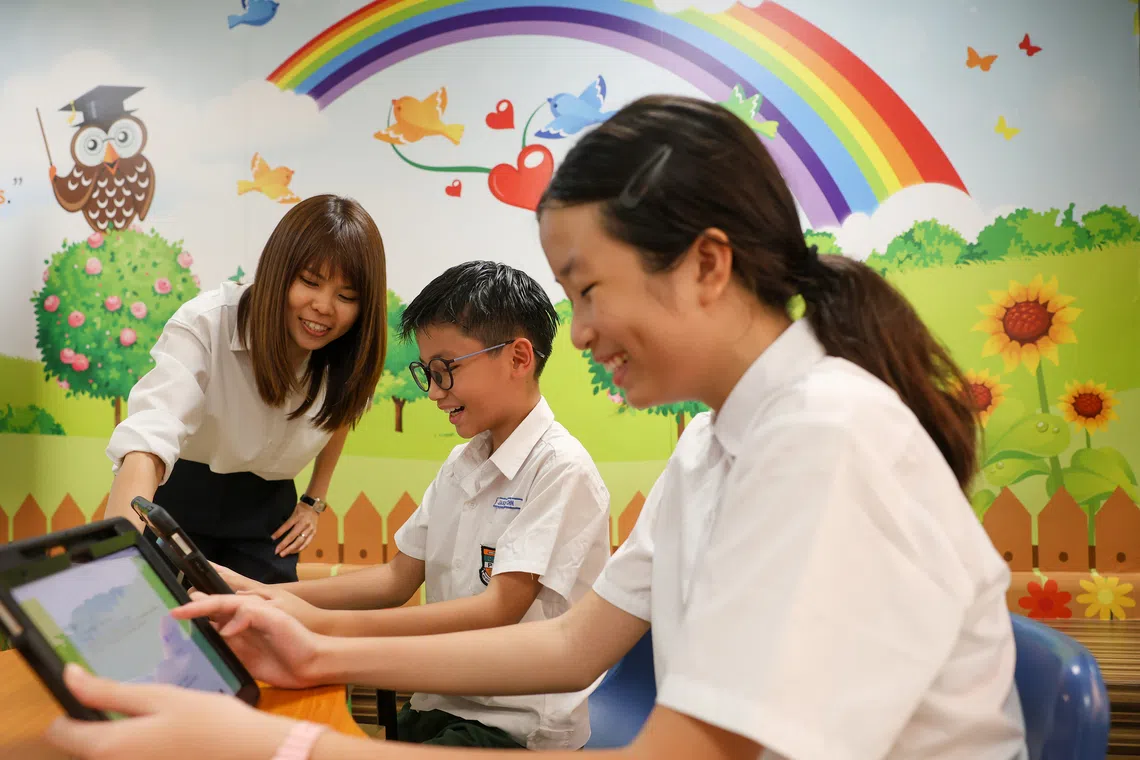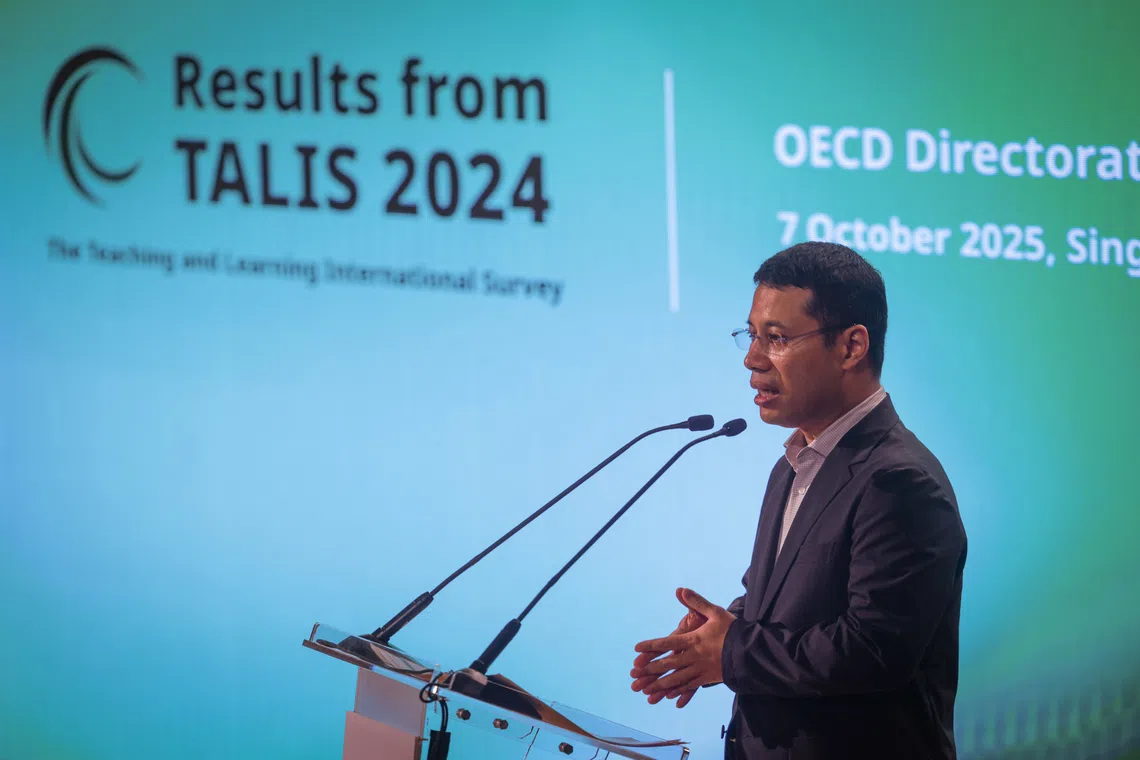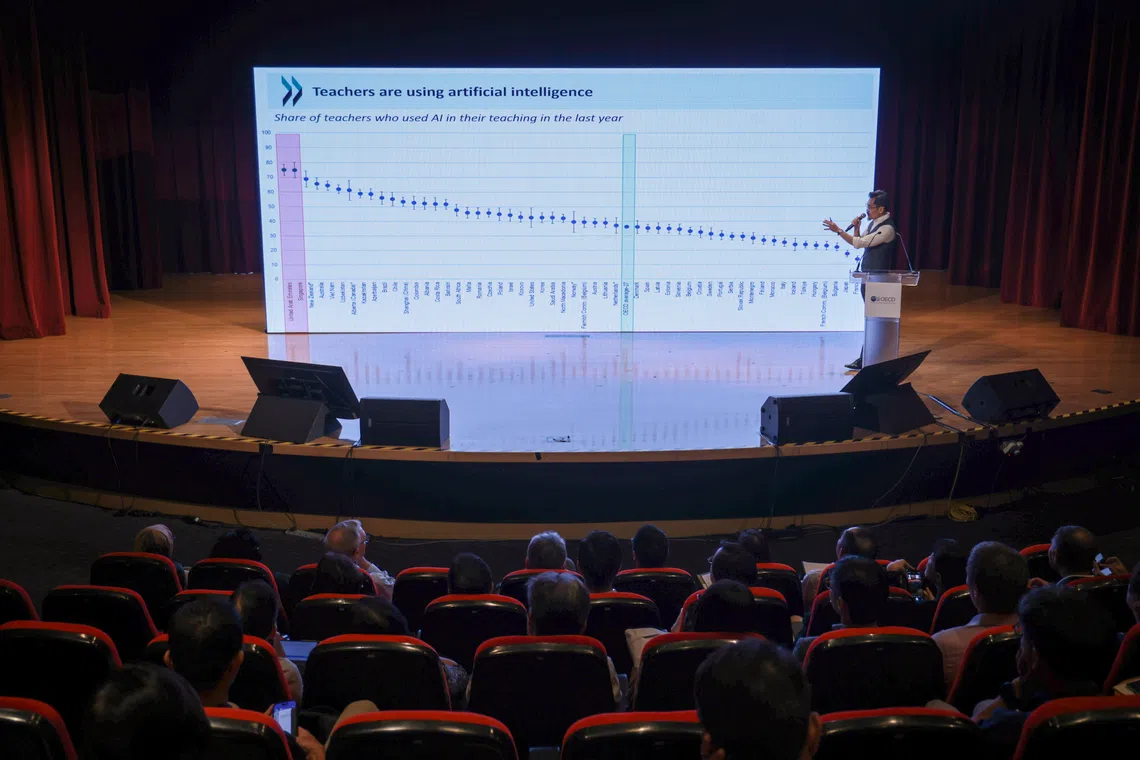3 in 4 Singapore teachers use AI, more than double overseas peers: OECD survey
Sign up now: Get tips on how to help your child succeed

The OECD survey findings show that teachers in Singapore are highly responsive to digital technologies, with adoption of AI among the highest globally.
PHOTO: MDDI
Follow topic:
- Singapore teachers are global leaders in AI use for education, with 75% adoption, exceeding the 36% overseas average (OECD Teaching and Learning International Survey).
- Singapore teachers believe that AI is useful in lesson planning (82%) and administrative tasks (74%).
- Only 38% of Singapore teachers feel confident supporting students with special education needs, lower than the OECD average of 62%.
AI generated
SINGAPORE – Teachers in Singapore are among the world’s most active users of artificial intelligence (AI) in education, with 75 per cent of them using it to teach or support student learning.
This is more than double the 36 per cent among overseas counterparts who do so, according to the results of a new global teaching survey released on Oct 7
Singapore teachers also see that AI has benefits: 82 per cent agree that using such tools helps them formulate or improve their lesson plans, and 74 per cent agree that AI can automate administrative tasks.
Overall, the findings from the latest Teaching and Learning International Survey (Talis) showed that teachers here are highly responsive to digital technologies, and are among the highest adopters of AI, but also the most wary of errors from it.
The survey of teachers across the world was conducted by the Organisation for Economic Cooperation and Development to help countries review policies to improve their teaching profession.
The report provides information on teacher education and professional development, workload, instructional beliefs and teaching practices.
Around 3,500 teachers and principals across Singapore’s 145 secondary schools and 10 private secondary schools, were polled from April to August 2024. Overall, 194,000 teachers across 55 education systems took part in the survey.
This is Singapore’s third time taking part in the survey, after rounds in 2013 and 2018. The survey was previously conducted every five years and, now, every six.
The latest edition is the first to examine teachers’ use of AI in teaching and learning, as well as their adoption of online and hybrid teaching methods.
Teachers in Singapore use AI most often to efficiently learn about and summarise topics (77 per cent), generate student feedback or communication with parents (69 per cent), and create lesson plans or activities (65 per cent), the study found.
This is followed by 40 per cent of teachers using AI to help students practise new skills in real-life scenarios, and the same proportion using it to automatically adjust the difficulty of lesson materials according to students’ needs.
AI is least used for assessing or marking student work (34 per cent), reviewing data on student participation or performance (28 per cent), and supporting students with special education needs (16 per cent).
Such tools used by teachers range from those developed by the Ministry of Education (MOE)
Talis also looked at teachers’ opinions about AI in teaching and found that 88% of teachers from Singapore “agreed” or “strongly agreed” that AI makes incorrect or inappropriate recommendations. This figure is the highest globally, with the OECD average at 66%.
Speaking at the launch of the survey findings on Oct 7, Education Minister Desmond Lee said that even as AI and technology transform how people work and learn, students need to develop important soft skills alongside these changes.
These include inventive and adaptive thinking skills, critical thinking skills, cross-cultural literacies, collaboration, empathy and resilience, said Mr Lee.
The launch, held at the MOE building in Buona Vista, was attended by teachers and other stakeholders.
“These have always been important, but are becoming more crucial,” he said. “Our students need to deepen these key human competencies that are not so easily replaceable by AI and other technologies.”
Even amid these changes in what students have to learn, teachers remain fundamental to education, Mr Lee said. “Technology cannot replace the human touch and care that our teachers bring.”

Education Minister Desmond Lee said that even as AI and technology transform how people work and learn, students need to develop important soft skills alongside these changes.
ST PHOTO: JASON QUAH
MOE director-general of education Liew Wei Li said that it is heartening that Singapore teachers are able to incorporate AI into teaching, despite it being fairly new.
“They’re also using it to improve the productivity of their work and to analyse how the students are learning,” she added.
The Talis study found that 81 per cent of teachers in Singapore work in schools that conduct online or hybrid modes of lessons – one of the highest adoption rates for such teaching methods, compared with the OECD average of 16 per cent.
Hybrid modes refer to formats like home-based learning, which has become a regular feature in schools here since the Covid-19 pandemic.
Teacher workload and use of AI
Teachers in Singapore reported working an average of 47.3 hours a week, up slightly from the 46 hours in 2018 and above the OECD average of 41 hours.
Lesson preparation time rose by 0.9 hours to 8.2 hours a week, while time spent marking dropped from 7.5 hours to 6.4 hours. Administrative work held steady at around four hours.
An MOE spokesman said: “It takes time and effort for teachers to learn new tools, integrate these into their practices and improve on them continuously.”
He added that the ministry tracks only usage and not the time saved from using these tools. “It would be challenging to estimate the net time saved from AI utilisation, given that teachers would likely fill up the time saved by engaging in other meaningful activities.”
Mrs Helen Tan-Lee, principal of Hillgrove Secondary School, said most teachers use AI both in teaching and administrative work, such as generating first drafts of parent communications, collating survey responses or staying updated on education trends.
Some teachers initially faced challenges learning new tools, she said, but peer-sharing sessions and more training have helped them adapt.

Overall, the findings from the latest Teaching and Learning International Survey show that teachers here are highly responsive to digital technologies, and are among the highest adopters of AI, but also the most wary of errors from it.
ST PHOTO: JASON QUAH
Ms Sabrina Soh, a Hillgrove Secondary School teacher, uses AI mainly for brainstorming, providing students with immediate feedback and getting a quick snapshot of students’ answers.
She also uses AI to design engaging lessons, such as generating visuals, storylines or real-world scenarios, which would have otherwise taken a longer time. “Now, I can generate multiple drafts quickly and spend my time refining the best one,” she said.
MOE’s feedback assistant also lightens her marking load, giving students immediate feedback and freeing her to spend time on deeper interactions with students, more precise marking, and professional collaboration with colleagues.
While Singapore teachers are strong adopters of technology, fewer feel confident in supporting students with special education needs, according to the Talis survey.
Fewer teachers here – 38 per cent compared with the OECD average of 62 per cent – feel they can design suitable learning tasks “quite a bit” or “a lot” for students with special education needs.
In addition, 55 per cent said they can work with other professionals and staff to teach such students to similar extents, below the OECD average of 72 per cent.


